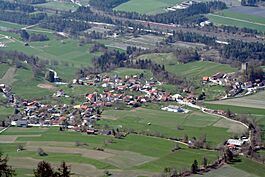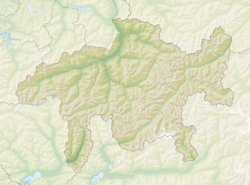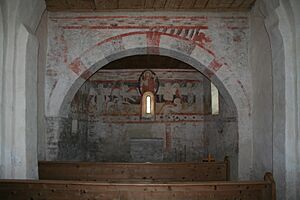Paspels facts for kids
Quick facts for kids
Paspels
|
|
|---|---|
 |
|
| Country | Switzerland |
| Canton | Graubünden |
| District | Hinterrhein |
| Area | |
| • Total | 4.59 km2 (1.77 sq mi) |
| Elevation | 778 m (2,552 ft) |
| Population
(Dec 2013)
|
|
| • Total | 475 |
| • Density | 103.49/km2 (268.0/sq mi) |
| Postal code |
7417
|
| Surrounded by | Almens, Cazis, Rodels, Trans, Tumegl/Tomils |
Paspels (called Pasqual in Romansh) was once a small town, or municipality, in the Graubünden area of Switzerland.
On January 1, 2015, Paspels joined with a few other nearby towns. These were Almens, Pratval, Rodels, and Tomils. Together, they formed a new, larger municipality called Domleschg.
Contents
History of Paspels
Paspels is a very old place! It was first written about in the year 1237. At that time, it was called in villa Pascuals. Later, in 1246, it was mentioned again as de Pascuals.
Geography and Nature
Before it joined with other towns, Paspels covered about 4.6 square kilometers (about 1.8 square miles).
A big part of this land, about 33%, was used for farming. Over half of the area, about 57%, was covered in forests. The town itself, with its buildings and roads, took up about 6% of the land. The rest, about 4%, was made up of things like rivers or mountains.
Paspels is located in a valley called Domleschg. It has a main village that stretches out, and another part that is more clustered together. These areas are on a hill above the Hinterrhine river. There are also two smaller settlements called Dusch and Canova.
You can also find a lake called Canovasee in the area. It's a beautiful spot near Paspels.
People and Population
In 2013, Paspels had 475 people living there. Over the ten years before that, the number of people living in Paspels grew by about 11.8%.
In 2000, there were slightly more females (52.6%) than males (47.4%) living in Paspels. The population included people of all ages, from young children to older adults.
When people voted in the 2007 Swiss federal election, the most popular political group was the SPS. They received almost 40% of the votes. Other popular groups included the SVP, the FDP, and the CVP.
Most adults in Paspels (between 25 and 64 years old) have finished high school or gone on to higher education, like university.
Paspels had a very low unemployment rate, meaning almost everyone who wanted a job had one. In 2005, many people worked in farming, while others worked in factories or in service jobs like shops and offices.
Here's how the population of Paspels has changed over time:
| Year | Population |
|---|---|
| 1808 | 245 |
| 1850 | 323 |
| 1900 | 302 |
| 1950 | 350 |
| 1960 | 286 |
| 1970 | 289 |
| 1980 | 318 |
| 1990 | 358 |
| 2000 | 409 |
Languages Spoken
Most people in Paspels speak German. In 2000, about 94% of the population spoke German. The next most common language was Romansh, spoken by about 3.7% of the people. A small number of people also spoke Italian.
Here's a look at the languages spoken in Paspels over the years:
| Languages | Census 1980 | Census 1990 | Census 2000 | |||
|---|---|---|---|---|---|---|
| Number | Percent | Number | Percent | Number | Percent | |
| German | 246 | 77.36% | 320 | 89.39% | 386 | 94.38% |
| Romanish | 63 | 19.81% | 31 | 8.66% | 15 | 3.67% |
| Italian | 3 | 0.94% | 3 | 0.84% | 4 | 0.98% |
| Population | 318 | 100% | 358 | 100% | 409 | 100% |
Important Buildings and Heritage
Paspels has two very important historical buildings. They are the Church of S. Luregn/St. Lorenz and the Chapel of S. Maria-Magdalena. These are considered heritage sites of national significance in Switzerland.
The Church of S. Luregn/St. Lorenz is very old, dating back to the Early Middle Ages. It was first mentioned in 1237. This church was the main church for the people living on the right side of the Hinterrhein valley.
The Chapel of S. Maria-Magdalena was built in 1508. At first, it was connected to a monastery. However, in the 1500s, the people in the hamlet of Dusch changed their religion during the Protestant Reformation. Because of this, the chapel also changed and became a Protestant church.
Things to See
One interesting modern building in Paspels is the sixth form schoolhouse. It was built between 1996 and 1998 by architects Valerio Olgiati and Raphael Zuber.
See also
 In Spanish: Paspels para niños
In Spanish: Paspels para niños







